Page 249 of 588

249 2-3. Operating the lights and wipers
2
When driving
VERSO_WE_OM64524E
The headlight cleaner operation (if equipped)
Vehicles without smart entry & start system
When the windshield washer is operated with the engine switch in the
“ON” position and the headlights turned on, the headlight cleaners will
operate once. (Afterwards, the headlight cleaners operate automatically
once for every 5 times the windshield washer is operated.)
To operate the headlight cleaners again, pull back the washer lever 5
times.
(If the headlights are turned off and then on again, and then the wind-
shield washer is operated, the headlight cleaners will operate once.)
Vehicles with smart entry & start system
When the windshield washer is operated with the “ENGINE START
STOP” switch in the IGNITION ON mode and the headlights turned on,
the headlight cleaners will operate once. (Afterwards, the headlight clean-
ers operate automatically once for every 5 times the windshield washer is
operated.)
To operate the headlight cleaners again, pull back the washer lever 5
times.
(If the headlights are turned off and then on again, and then the wind-
shield washer is operated, the headlight cleaners will operate once.)
Rain drop sensor (vehicles with rain-sensing windshield wipers)
Vehicles without smart entry & start system:
If the wiper switch is turned to the “AUTO” position while the engine
switch is in the “ON” position, the wiper will operate once to show that
“AUTO” mode is activated.
If the wiper sensitivity is adjusted to higher, the wiper may operate once to
indicate the change of sensitivity.
The raindrop sensor judges the amount
of raindrops.
Page 444 of 588
444 4-3. Do-it-yourself maintenance
VERSO_WE_OM64524E
*1: Vehicles with diesel engine
*2: Vehicles with gasoline engine
*3: Vehicles with diesel engine and automatic transmission
*4: Vehicles with discharge headlights
*5: Vehicles with halogen headlights47 EFI NO.1 10 AMultiport fuel injection system/
sequential multiport fuel injection
system, air flow meter, exhaust
system
*1
48 H-LP RH HI 10 A Right-hand headlight (high beam)
49 H-LP LH HI 10 A Left-hand headlight (high beam)
50 H-LP RH LO15 A
*4Right-hand discharge headlights
(low beam)
10 A
*5Right-hand headlight (low beam)
51 H-LP LH LO15 A
*4Left-hand discharge headlights
(low beam)
10 A
*5Left-hand headlight (low beam)
FuseAmpereCircuit
Page 460 of 588
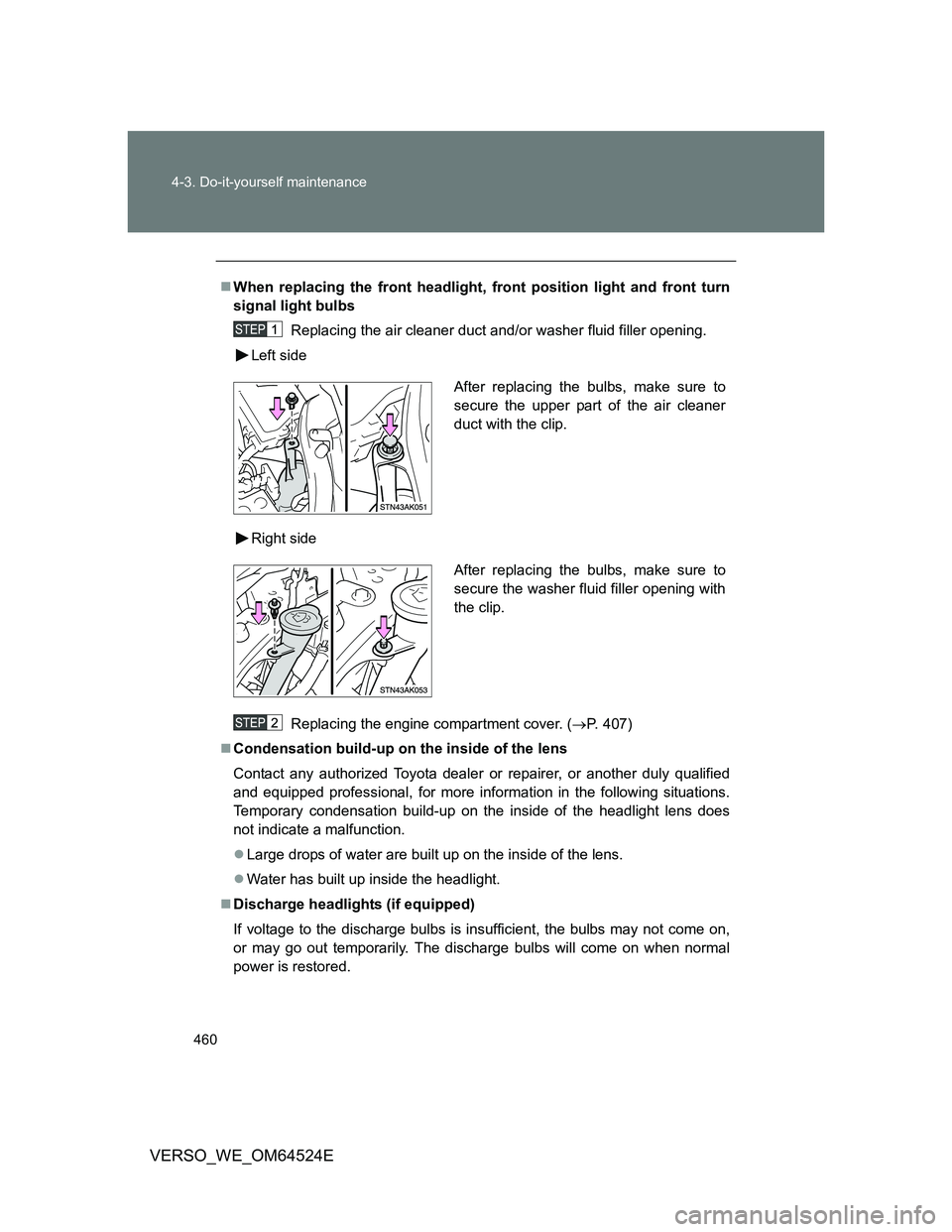
460 4-3. Do-it-yourself maintenance
VERSO_WE_OM64524E
When replacing the front headlight, front position light and front turn
signal light bulbs
Replacing the air cleaner duct and/or washer fluid filler opening.
Left side
Right side
Replacing the engine compartment cover. (P. 407)
Condensation build-up on the inside of the lens
Contact any authorized Toyota dealer or repairer, or another duly qualified
and equipped professional, for more information in the following situations.
Temporary condensation build-up on the inside of the headlight lens does
not indicate a malfunction.
Large drops of water are built up on the inside of the lens.
Water has built up inside the headlight.
Discharge headlights (if equipped)
If voltage to the discharge bulbs is insufficient, the bulbs may not come on,
or may go out temporarily. The discharge bulbs will come on when normal
power is restored.
After replacing the bulbs, make sure to
secure the upper part of the air cleaner
duct with the clip.
After replacing the bulbs, make sure to
secure the washer fluid filler opening with
the clip.
Page 461 of 588
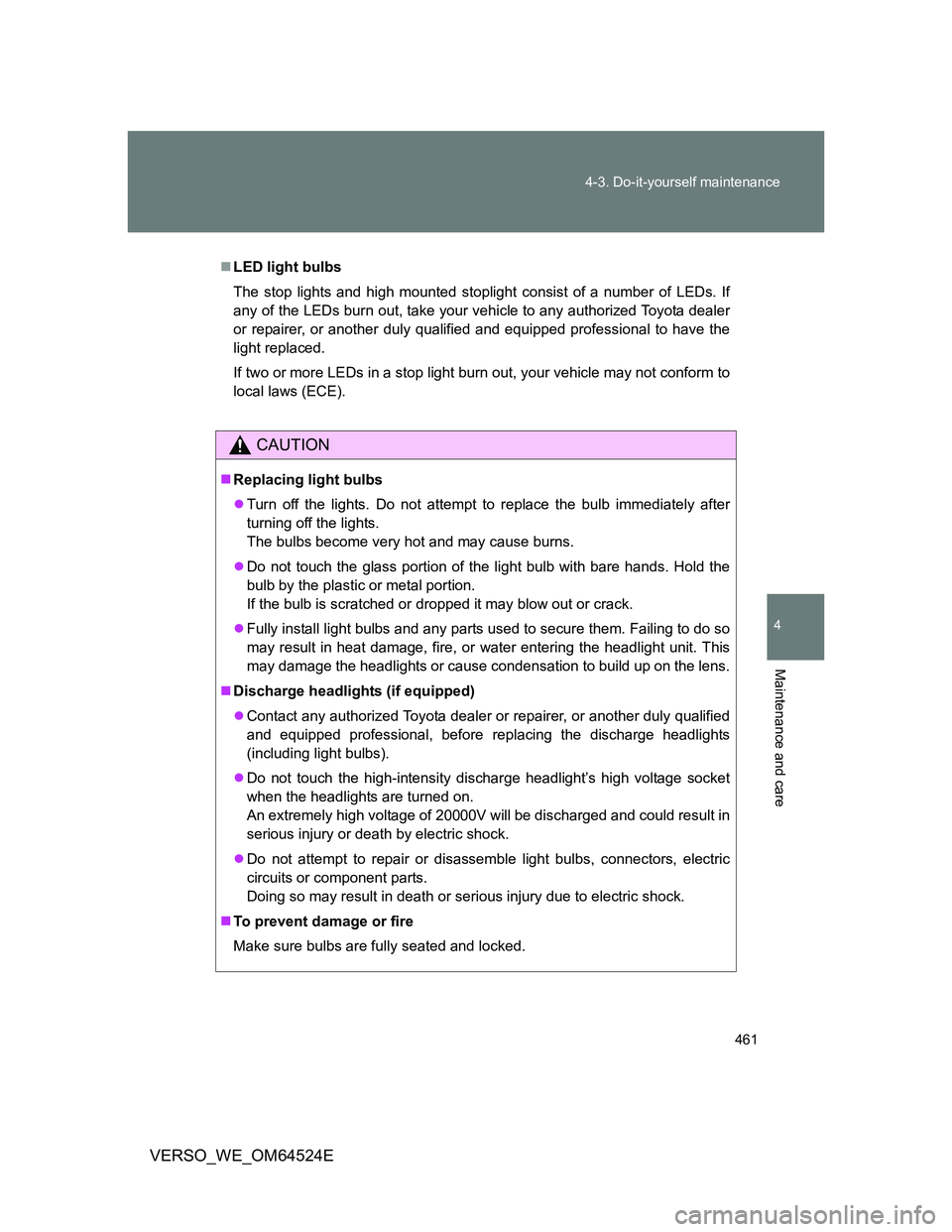
461 4-3. Do-it-yourself maintenance
4
Maintenance and care
VERSO_WE_OM64524E
LED light bulbs
The stop lights and high mounted stoplight consist of a number of LEDs. If
any of the LEDs burn out, take your vehicle to any authorized Toyota dealer
or repairer, or another duly qualified and equipped professional to have the
light replaced.
If two or more LEDs in a stop light burn out, your vehicle may not conform to
local laws (ECE).
CAUTION
Replacing light bulbs
Turn off the lights. Do not attempt to replace the bulb immediately after
turning off the lights.
The bulbs become very hot and may cause burns.
Do not touch the glass portion of the light bulb with bare hands. Hold the
bulb by the plastic or metal portion.
If the bulb is scratched or dropped it may blow out or crack.
Fully install light bulbs and any parts used to secure them. Failing to do so
may result in heat damage, fire, or water entering the headlight unit. This
may damage the headlights or cause condensation to build up on the lens.
Discharge headlights (if equipped)
Contact any authorized Toyota dealer or repairer, or another duly qualified
and equipped professional, before replacing the discharge headlights
(including light bulbs).
Do not touch the high-intensity discharge headlight’s high voltage socket
when the headlights are turned on.
An extremely high voltage of 20000V will be discharged and could result in
serious injury or death by electric shock.
Do not attempt to repair or disassemble light bulbs, connectors, electric
circuits or component parts.
Doing so may result in death or serious injury due to electric shock.
To prevent damage or fire
Make sure bulbs are fully seated and locked.
Page 519 of 588
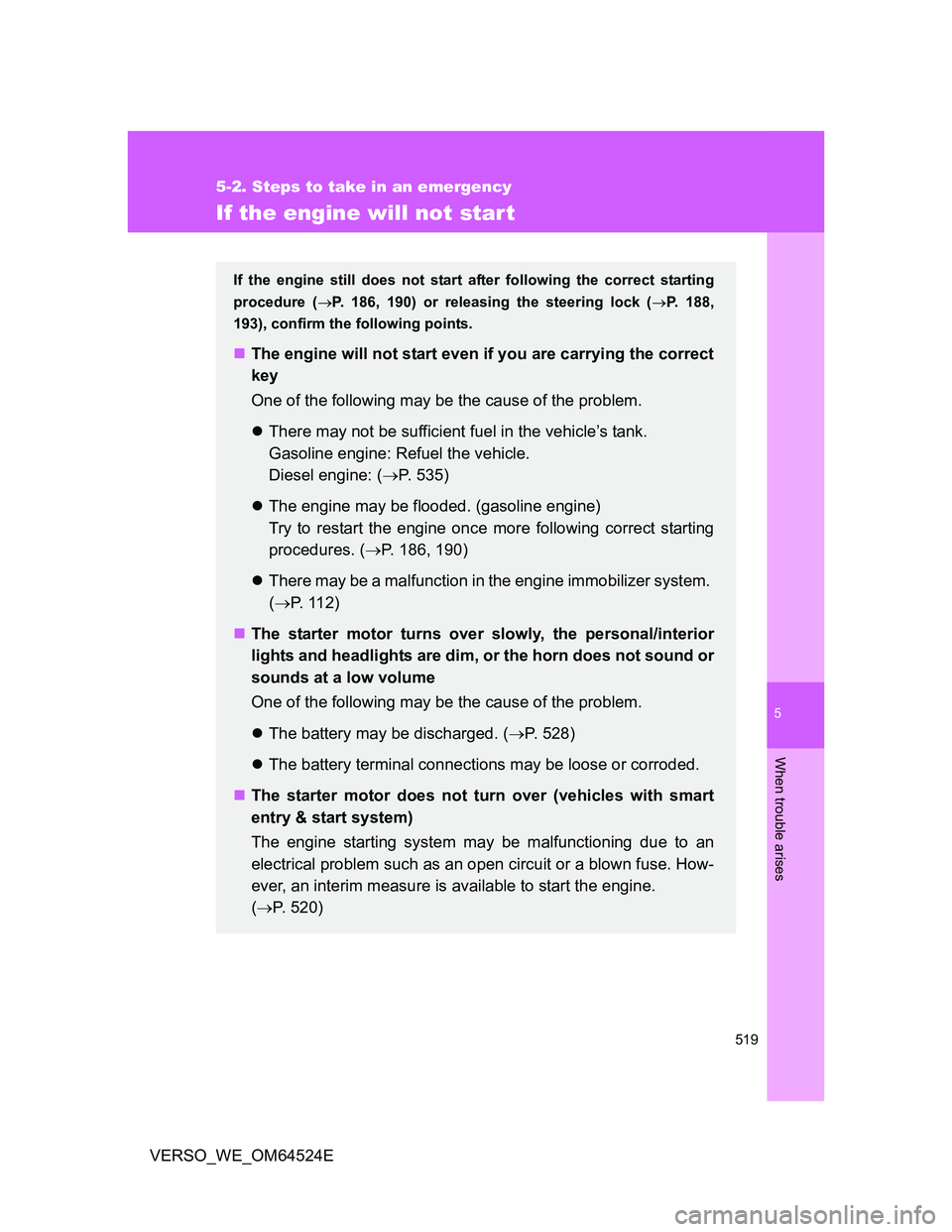
5
519
5-2. Steps to take in an emergency
When trouble arises
VERSO_WE_OM64524E
If the engine will not start
If the engine still does not start after following the correct starting
procedure (P. 186, 190) or releasing the steering lock (P. 188,
193), confirm the following points.
The engine will not start even if you are carrying the correct
key
One of the following may be the cause of the problem.
There may not be sufficient fuel in the vehicle’s tank.
Gasoline engine: Refuel the vehicle.
Diesel engine: (P. 535)
The engine may be flooded. (gasoline engine)
Try to restart the engine once more following correct starting
procedures. (P. 186, 190)
There may be a malfunction in the engine immobilizer system.
(P. 112)
The starter motor turns over slowly, the personal/interior
lights and headlights are dim, or the horn does not sound or
sounds at a low volume
One of the following may be the cause of the problem.
The battery may be discharged. (P. 528)
The battery terminal connections may be loose or corroded.
The starter motor does not turn over (vehicles with smart
entry & start system)
The engine starting system may be malfunctioning due to an
electrical problem such as an open circuit or a blown fuse. How-
ever, an interim measure is available to start the engine.
(P. 520)
Page 520 of 588
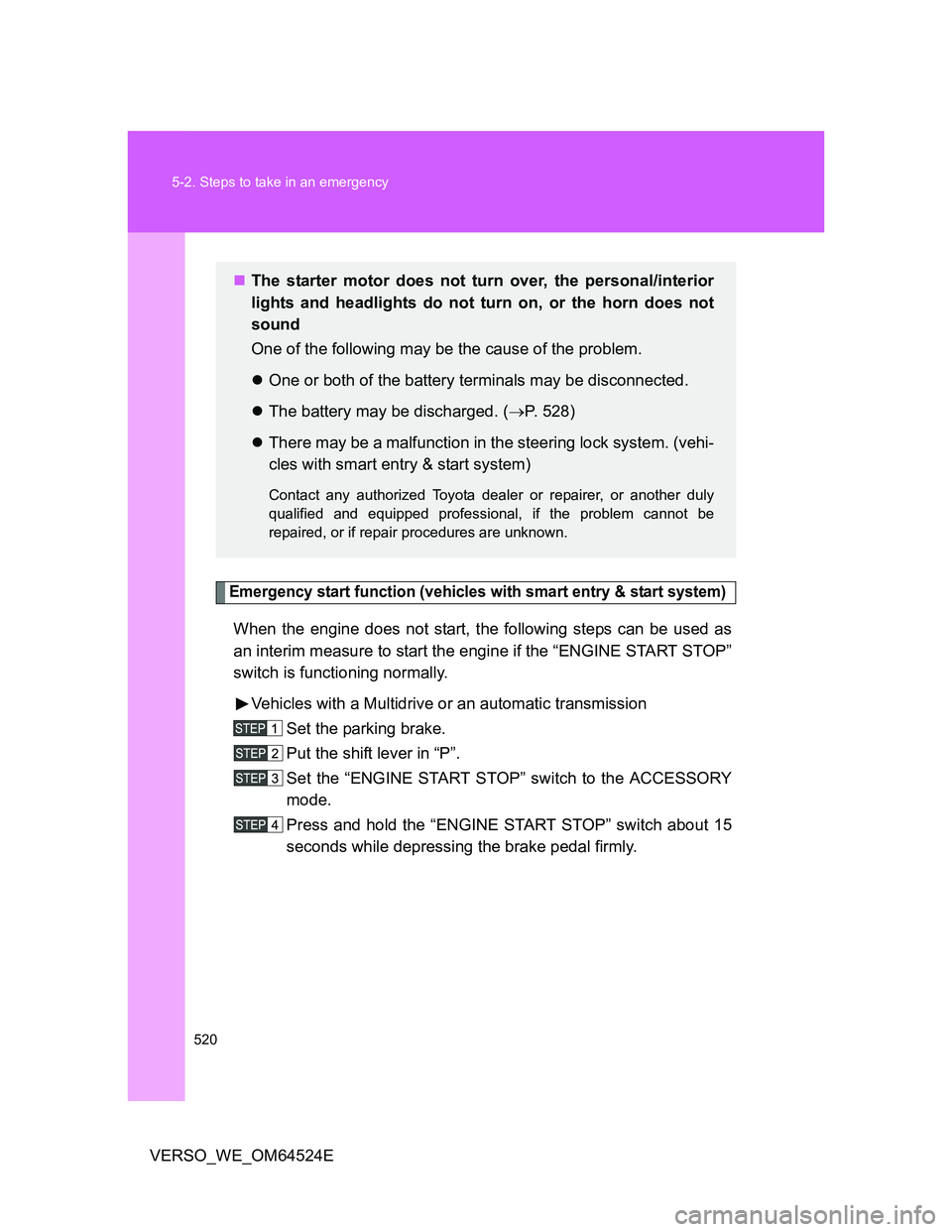
520 5-2. Steps to take in an emergency
VERSO_WE_OM64524E
Emergency start function (vehicles with smart entry & start system)
When the engine does not start, the following steps can be used as
an interim measure to start the engine if the “ENGINE START STOP”
switch is functioning normally.
Vehicles with a Multidrive or an automatic transmission
Set the parking brake.
Put the shift lever in “P”.
Set the “ENGINE START STOP” switch to the ACCESSORY
mode.
Press and hold the “ENGINE START STOP” switch about 15
seconds while depressing the brake pedal firmly.
The starter motor does not turn over, the personal/interior
lights and headlights do not turn on, or the horn does not
sound
One of the following may be the cause of the problem.
One or both of the battery terminals may be disconnected.
The battery may be discharged. (P. 528)
There may be a malfunction in the steering lock system. (vehi-
cles with smart entry & start system)
Contact any authorized Toyota dealer or repairer, or another duly
qualified and equipped professional, if the problem cannot be
repaired, or if repair procedures are unknown.
Page 529 of 588
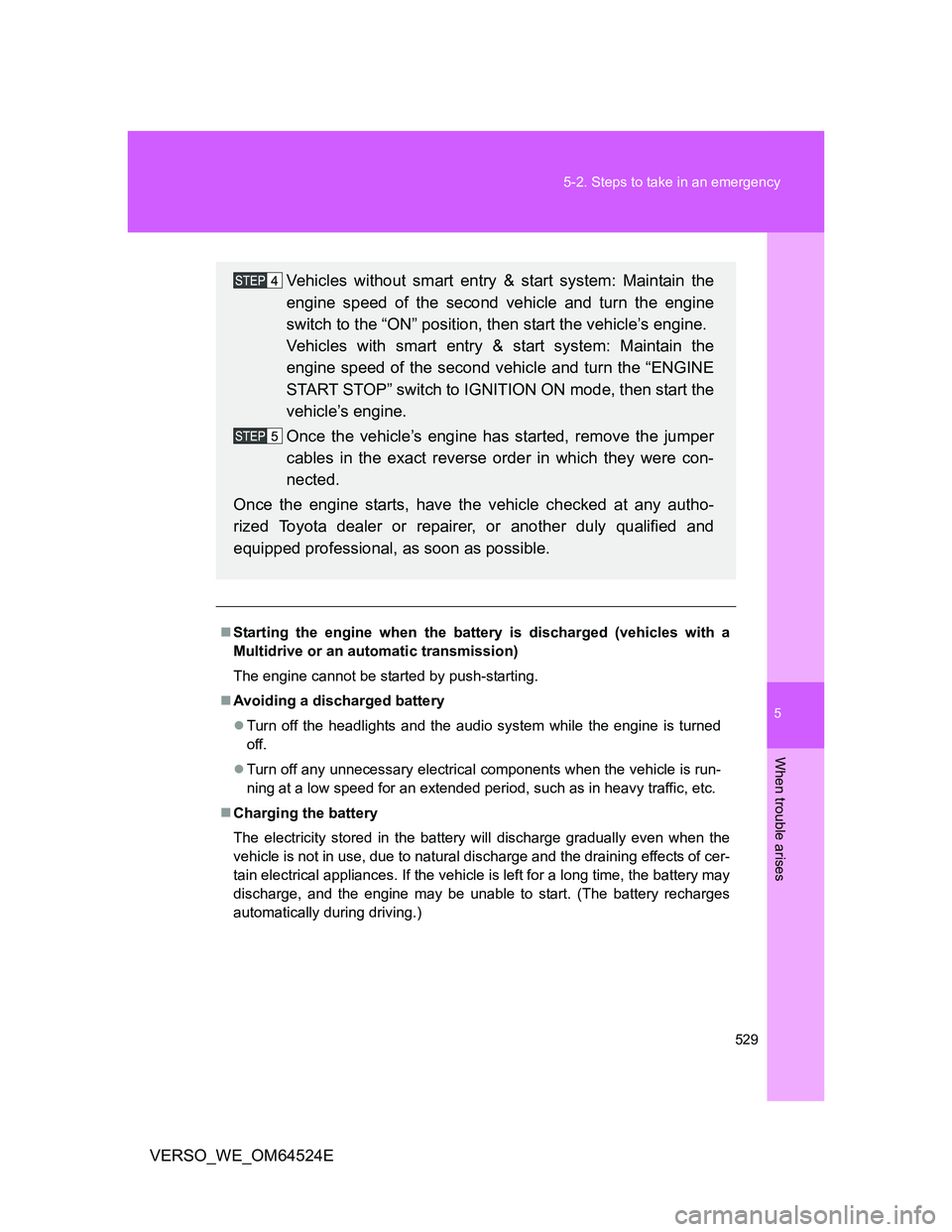
5
529 5-2. Steps to take in an emergency
When trouble arises
VERSO_WE_OM64524E
Starting the engine when the battery is discharged (vehicles with a
Multidrive or an automatic transmission)
The engine cannot be started by push-starting.
Avoiding a discharged battery
Turn off the headlights and the audio system while the engine is turned
off.
Turn off any unnecessary electrical components when the vehicle is run-
ning at a low speed for an extended period, such as in heavy traffic, etc.
Charging the battery
The electricity stored in the battery will discharge gradually even when the
vehicle is not in use, due to natural discharge and the draining effects of cer-
tain electrical appliances. If the vehicle is left for a long time, the battery may
discharge, and the engine may be unable to start. (The battery recharges
automatically during driving.)
Vehicles without smart entry & start system: Maintain the
engine speed of the second vehicle and turn the engine
switch to the “ON” position, then start the vehicle’s engine.
Vehicles with smart entry & start system: Maintain the
engine speed of the second vehicle and turn the “ENGINE
START STOP” switch to IGNITION ON mode, then start the
vehicle’s engine.
Once the vehicle’s engine has started, remove the jumper
cables in the exact reverse order in which they were con-
nected.
Once the engine starts, have the vehicle checked at any autho-
rized Toyota dealer or repairer, or another duly qualified and
equipped professional, as soon as possible.
Page 563 of 588
563 6-1. Specifications
6
Vehicle specifications
VERSO_WE_OM64524E
Light bulbs
A: H11 halogen bulbs B: D4R discharge bulbs
C: HB3 halogen bulbs D: Wedge base bulbs (amber)
E: Wedge base bulbs (clear) F: Single end bulbs (amber)
G: Single end bulbs (clear) H: Double end bulbs
Light BulbsWTy p e
ExteriorHeadlights
Low beam (Halogen bulbs)
Low beam (Discharge bulbs)
High beam55
35
60A
B
C
Front fog lights (if equipped) 55 A
Front position lights 5 E
Front turn signal lights 21 F
Rear turn signal lights 21 F
Tail lights 5 G
Back-up lights 21 G
Rear fog lights 21 G
License plate lights 5 E
Side turn signal lights 5 D
InteriorPersonal/interior lights 5 E
Personal lights 8 E
Vanity lights 8 E
Door courtesy lights 5 E
Luggage compartment light 5 H